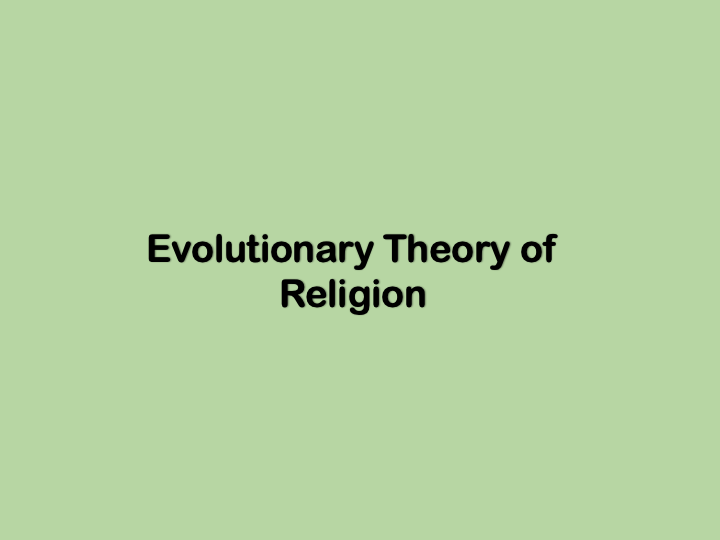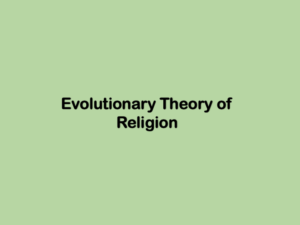What is the Evolutionary Theory of Religion?
The Evolutionary Theory of Religion proposes that modern Abrahamic religious thought evolved over centuries. The first religions were animistic, but developed into polytheistic pantheons. When Israelites settled in the Levants, they originally adopted the surrounding, polytheistic religions of Canaan. Over the centuries, they incorporated aspects of Egyptian, Babylonian, and Persian religious thought. Judaism, and the Hebrew Bible, was not formulated into its modern form until sometime during the divided kingdom period of Israel. Christianity, and in turn Islam, then evolved out of Judaism. In this post, we explore, analyze, and evaluate the Evolutionary Theory.

The evolutionary theory is a theory about to origin of religion that proposes that Judaism (and the other Abrahamic religions: Christianity and Islam) started as a polytheistic religion borrowed from the surrounding cultures. Religious thought continued to change over the centuries, slowly becoming first Judaism and later Christianity.
While this seems more like a thought experiment than a viable theory, there is some evidence behind the theory, mostly the similarities between various ancient religions. When compared with the Ancient religious writings of Babylon, Sumeria and Canaan, similar themes and events emerge, particularly in the creation story and the flood story.
Another similarity is one of the names for God. As was mentioned in another post, Elohim is one of the names for God in the Old Testament. Elohim is plural, but the Hebrew root el- means god. It turns out that El was also a name for a god in ancient Canaanite religious texts.
In 1929, a farmer unearthed a tomb in northern Syria. French archeologist began excavating the site and discovered the ancient port city of Ugarit. Ugarit is notable because the language, Ugaritic, was a semitic language and was very similar to ancient Hebrew. Archeologist unearthed several collections of clay tablets, shedding light on the language, religion and politics of the time (Ugarit was suddenly destroyed around 1190 BC).
Ugarit was also a Canaanite nation, so it gives a special insight into Canaanite religions around the time of the establishment of Israel as a nation. Chief among the religious documents recovered from Ugarit was a series of tablets known as the Ba’al cycle.
The Ba’al cycle was the Ugaritic version of the creation story. The protagonist of the cycle was the god Ba’al, infamous from the Old Testament as a foreign god who competed with God for the worship of the Israelites. The chief god in the Ba’al cycle, the father of the other gods, however, was a god named El.
Some scholars point to this fact, in conjunction with other observed similarities, to propose that Judaism, with its worship of a monotheistic God, started in the local polytheistic Canaanite religions. The polytheistic father god El of Ugarit evolved into the monotheistic Elohim of the Hebrew religion. Over the centuries, Jewish religious thought incorporated elements of other, nearby, Ancient Near Eastern religious systems into their theology. From Canaanite religion, elements of Egyptian religious thought were incorporated first, then followed by elements of Babylonian theology. In this theory, it is not until the time of the Babylonian exile the Jewish religious thought reached its mature, final form.
There are, however, several problems with this theory. One is that it doesn’t explain why Elohim is plural. El is the Baal cycle is singular. How did that evolve into Elohim, or gods?
There are multiple supernatural beings in the Old Testament and a close reading of the Hebrew Bible reveals that many of them, not just God, are labeled elohim. Among the beings listed as elohim are God, angels, evil spirits (shedim), foreign gods, and the dead spirit of the prophet Samuel. This is an intriguing observation, and we’ll return to it in the post on the Divine Council theory, but it doesn’t necessarily mean El of Ugarit became Elohim in Genesis 1.
The biggest criticism of the evolutionary theory is that it argues against the divinity of God. According to the theory, God is not an actual being, but a fictional character created by mankind to fill certain psychological needs. If there is no God, then there is no son of God. Judaism, Christianity, and Islam are all fictional constructs, and the Bible is a collection of fictional stories accumulated over time.
From a theological standpoint, this explanation does not meet our needs because it denies the existence of God as well as divine inspiration of the Bible. As we discussed in the post on the necessary assumptions for this blog, we feel that in order for the Bible to be reliable, it must have been inspired by God. In other words, God is responsible for the content of the Bible, but it was written by humans.
This doesn’t mean we should ignore opposing viewpoints, however. We can analyze he evolutionary theory from a literary standpoint and see if there is textual evidence for this view in the Bible. Indeed, the similarities and contrasts between the Bible and ancient religious texts are going to be a recurring topic in this blog.
It is interesting to note that while there are definitely Egyptian and Babylonian religious motifs and images in the Old Testament, the Bible is written where God usually takes a confrontational stance against these other religions.
For example, in Exodus, God brings the plagues on Pharoah. Scholars have pointed out that each of the plagues is a direct attach by God on a specific Egyptian deity. Likewise, the Canaanite god Ba’al is mentioned numerous times in the Old Testament. God, however, very clearly warns against the dangerous worship of Ba’al.
This raises the very interesting question of why does God place himself in opposition of foreign gods? Is it because these are false religions made up by man, or because these are actual supernatural beings who oppose the rule of God. For many believing Jews and Christians, this idea is uncomfortably close to polytheism.
One argument is all of these foreign religions are false, and the Bible attempts to set the story straight by documenting that Yahweh is the one and true God. In fact, this very statement is used repeatedly in the Bible.
In this narrative, God is the creator and is the only god. However, soon after mankind was created, they began to stray from the worship of God and instead began to create their own religions. As the millennia passed, man made up more and more gods, and in many cultures the worship of Yahweh was forgotten, replaced by the worship of false gods. The Bible is God’s means of setting the record straight, and telling the true story.
To get back to the evolutionary theory, is there any good evidence for it? The answer is no. There is no smoking gun, such as an ancient document that chronicled the evolution of religion. However, the absence of evidence doesn’t make the theory wrong, it just makes it speculative.
In modern times, the most scholars don’t ascribe to the evolutionary theory. Instead, the majority view among scholars is instead the Documentary Theory, which proposed the first five books of the Bible are the result of the compiling and editing of four different Jewish traditions that evolved over hundreds of years. The Documentary Theory has very similar problems to the evolutionary theory, and we’ll dive deeper in the documentary theory in the next post in this series.
A concise summary of this theory can be found here (https://www.thearchaeologist.org/blog/the-evolution-of-god-cultural-confluences-and-the-shaping-of-christian-theology).







